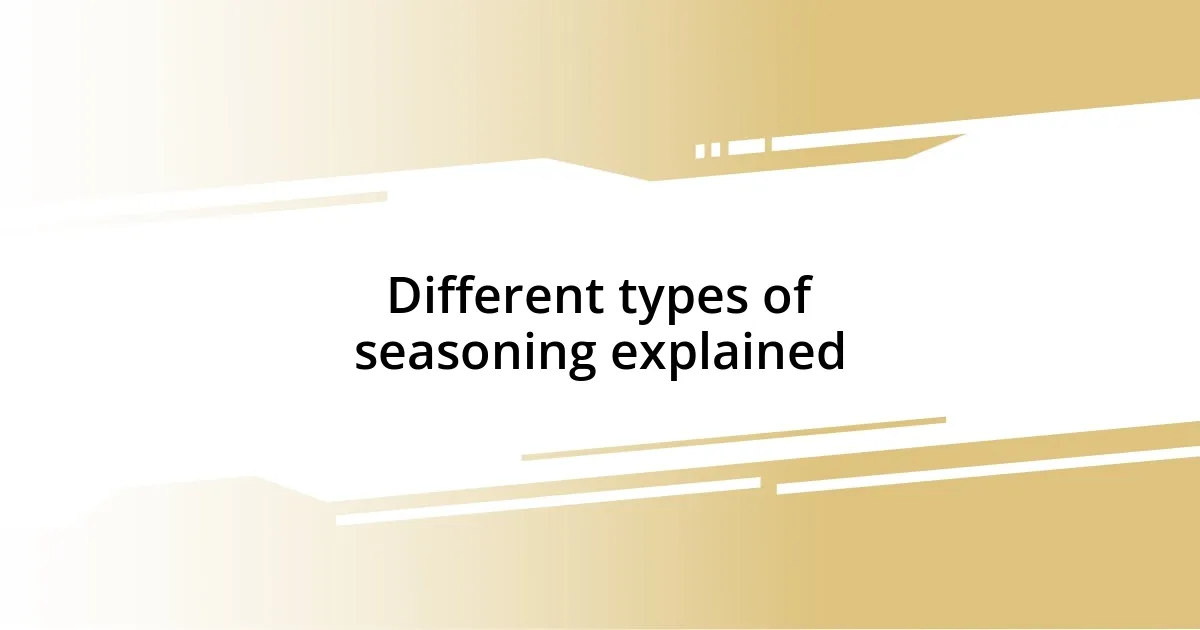Key takeaways:
- Seasoning transforms dishes by enhancing natural flavors and creating memorable culinary experiences.
- Utilizing the right tools, like a mortar and pestle or measuring spoons, can significantly improve the seasoning process.
- Balancing flavors through techniques such as layering and timely spice addition is crucial for achieving depth in cooking.
- Developing a personal seasoning style reflects individual taste preferences and can be refined through experimentation and journaling.

Understanding the importance of seasoning
Seasoning is truly the secret behind elevating a dish from good to unforgettable. I vividly remember the first time I sprinkled a pinch of salt into my grandmother’s famed pasta sauce. Suddenly, the flavors popped in a way I never thought possible. That moment opened my eyes to how seasoning can transform ingredients by enhancing their natural characteristics.
Have you ever tasted something that felt a bit bland? It’s often because it’s missing that essential layer of flavor imparted by seasoning. For me, understanding that simple addition of herbs or spices can bring a dish to life was a game-changer in my cooking journey. Just the other day, I tossed some fresh basil into a tomato salad, and the brightness it added reminded me why I fell in love with cooking in the first place.
With seasoning, it’s not just about taste; it’s about creating an experience. Every pinch tells a story—I sometimes think about my late father’s love for garlic, and how it infused warmth into every meal he prepared. This emotional connection can be the key to ensuring that your dishes resonate with those around you. Are you ready to explore how this simple yet profound practice can change your cooking forever?

Different types of seasoning explained
When I think about the different types of seasoning, it really fascinates me how varied they are and how each one brings its unique flavor to the table. Spice blends, for example, can create an entirely different culinary experience. One time, I experimented with a homemade taco seasoning while prepping dinner for friends, and the blend of cumin, paprika, and oregano was so well received that we ended up turning it into a mini taco night tradition.
Here’s a simple breakdown of various types of seasoning:
- Salt: Enhances flavors and is essential for balancing taste.
- Herbs: Fresh or dried, like basil or thyme, add aromatic qualities.
- Spices: Ground or whole, such as cinnamon or black pepper, can create warmth and depth.
- Seasoning blends: Commercial mixes like Italian seasoning or curry powder can save time while adding complexity.
- Acids: Ingredients like vinegar or citrus juices brighten dishes and enhance flavors.
- Umami-rich ingredients: Soy sauce or miso can provide that savory depth; I vividly recall using soy sauce in a stir-fry that made my taste buds dance.
Understanding these different types helps me to craft dishes that are not only flavorful but also memorable, turning every meal into an event.

Tools for seasoning effectively
| Tool | Purpose |
|---|---|
| Mortar and Pestle | Perfect for grinding spices and releasing their essential oils. |
| Salt Shaker | Ensures even distribution of salt, making seasoning effortless. |
| Measuring Spoons | Helps achieve precise measurements, essential for consistent flavor. |
| Chef’s Knife | Essential for chopping fresh herbs that can dramatically enhance a dish. |
Using the right tools can be a game-changer in the seasoning process. For instance, when I discovered the mortar and pestle, it felt like uncovering a hidden gem in my kitchen. There’s something deeply satisfying about grinding whole spices, releasing those aromatic oils that bottled versions simply can’t match. I distinctly recall making a curry from scratch, and the fresh ground spices created a flavor profile that transported me right back to my travels in India.
Another essential tool for seasoning effectively is the salt shaker. It might seem simple, but having one means I can easily sprinkle salt onto my dishes without overwhelming them. I remember a time when I was at a friend’s dinner, and we were cooking together. She forgot to use a shaker and ended up dumping salt into the dish. The result was an overly salty mess that overshadowed the beautiful ingredients we were using. That evening taught me the value of proper tools in achieving the perfect balance of flavors.
Lastly, I can’t emphasize enough the importance of measuring spoons. It’s easy to get carried away when seasoning, especially with something as tantalizing as fresh herbs. While I often rely on intuition, there have been occasions when I’ve over-seasoned a dish because I didn’t measure. The memories of those occasionally salty or unexpectedly spicy meals serve as reminders that, with the right tools and a little attention, I can elevate my cooking to new heights.

Techniques for balancing flavors
Balancing flavors in cooking is an art that I’m still mastering. One technique I often use is starting with a base of salt or acid—like lemon juice or vinegar—to set the tone for the dish. I remember a particularly satisfying moment when I roasted vegetables and drizzled them with balsamic vinegar right before serving. The sweetness of the balsamic cut through the earthiness of the veggies, transforming them into a delightful harmony on the plate. Have you ever experienced a moment when a simple touch elevated a dish?
Another approach I find effective is layering flavors throughout the cooking process. For instance, adding herbs at different stages can create depth. I learned this the hard way during a simple tomato sauce preparation. I tossed in fresh basil at the end, and while it was good, I realized that simmering some dried herbs early on infused the sauce with a richer flavor profile. It’s the kind of lesson that sticks with you, right? Trust me; don’t just toss in the herbs at the end and call it a day!
I often reflect on how sweet and spicy elements play off each other. It’s like a little dance on the palate! For example, in my favorite spicy barbecue sauce, I balance the heat from chili powder with a hint of honey. It reminds me of summer backyard gatherings where friends would ask for the recipe, completely surprised by how balanced the sauce was. Isn’t it amazing how a bit of sweetness can cut through spice and create that memorable flavor experience? Those are the moments I cherish in my culinary journey.

Tips for seasoning various cuisines
When it comes to seasoning various cuisines, I find that understanding the essence of each style is crucial. For instance, Thai cuisine often relies on that perfect harmony of salty, sweet, sour, and spicy. The first time I made a Pad Thai, I was nervous about the balance. But once I mixed tamarind paste with fish sauce and a touch of sugar, it was like the flavors danced together on my tongue! Have you ever tasted a dish and thought, “Wow, that’s exactly what it should taste like?” That moment for me was a turning point in appreciating the complexity of different cuisines.
When seasoning Italian dishes, fresh herbs reign supreme. I typically turn to basil, oregano, and parsley, allowing them to shine through in simple recipes like marinara sauce. I’ll never forget the aroma of fresh basil filling my kitchen after I chopped it for the first time—it felt like bringing a piece of summer indoors. I often ask myself, “How does each herb contribute to the overall flavor?” The answer is in the layers; starting with sautéed garlic and onion creates a savory base that supports those vibrant herbs beautifully.
For Mexican cuisine, I lean heavily on spices like cumin, coriander, and chili powder. I remember experimenting with these when I was tasked with making the perfect taco seasoning. The blend of earthy cumin with the heat of chili powder created a mix that made my friends rave about taco night! Have you ever had that feeling when a dish exceeds your expectations? I realized that the key was in toasting the spices slightly before using them; it truly brings out their full flavor potential. Each seasoning tells a story, and understanding those stories in different cuisines can take your culinary adventures to exciting new heights!

Common seasoning mistakes to avoid
One of the most common mistakes I’ve noticed in the kitchen is skimping on salt. It can be tempting to hold back, especially if you’re watching your sodium intake, but under-seasoning can leave your dish flat. I remember preparing a soup and thinking, “Just a pinch will do.” If only I had added a bit more salt earlier! It took me years to understand that salt not only enhances flavor but also brings out the natural depth of other ingredients. Have you ever tasted a dish and wondered why it didn’t quite hit the mark?
Another blunder I’ve encountered is neglecting the importance of timing when adding spices. I’ve learned the hard way that spices need time to bloom. In one of my early attempts at curry, I tossed in the spices just before serving, thinking that would do the trick. The flavor was lackluster, almost like a quick jog without warming up. Now, I always let my spices simmer for a few minutes before diving into a dish. When have you felt that a cooking step made all the difference?
Lastly, I can’t stress enough the importance of tasting as you go. It’s too easy to get caught up in the excitement of cooking and forget this crucial step. I recall a particularly enthusiastic batch of chili where I thought I’d nailed it. But after not tasting until the end, I was left with a surprisingly overwhelming heat that not even a dollop of sour cream could fix. It’s a learning experience I hold dear—tasting throughout the process not only guides my seasoning but also helps me connect with the dish I’m creating. Have you made that mistake too? Just remember, a few little tastes can lead to a whole world of improvement!

Developing your personal seasoning style
Developing your personal seasoning style is a wonderful journey that reflects who you are as a cook. I remember when I first started experimenting with different flavor profiles; it felt like an artist mixing colors for the first time. I found that the more I explored my taste preferences, the more my dishes transformed. Have you ever noticed how a simple adjustment can completely change a meal? That’s the magic of seasoning!
As I honed my skills, I realized that my mood often influenced how I seasoned my dishes. For instance, on days when I felt adventurous, I would sprinkle smoked paprika into my sauces, creating a depth I never thought possible. Other times, I embraced the comfort of garlic and herbs, reflecting a desire for warmth and familiarity. Have you found that your emotional state shapes the flavors you crave? It’s such a personal connection to food—one that evolves with each meal and every new ingredient.
I also discovered that keeping a journal of my seasoning attempts helped me refine my style. I’d jot down not just the spices I used but also how I felt about the resulting flavor. I remember one evening where I mixed an unusual combination of nutmeg and cayenne in a pumpkin soup. The initial uncertainty turned into sheer delight, and that specific flavor pairing became a cornerstone of my seasonal recipes. What flavor combinations have surprised you in your kitchen? Documenting these moments allowed me to create a unique seasoning style tailored to my tastes.














